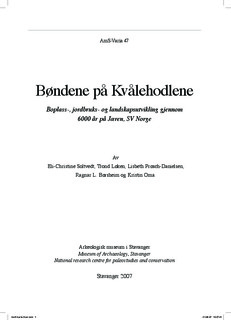| dc.identifier.citation | Soltvedt, E-C, Løken, T., Prøsch-Danielsen, L. et al. (2007) Bøndene på Kvålehodlene : boplass-, jordbruks- og landskapsutvikling gjennom 6000 år på Jæren, SV Norge. Stavanger : Arkeologisk museum i Stavanger | nb_NO |
| dc.description.abstract | In order to reconstruct the settlement-, agriculture- and land-use practises within the Kvåle-complex,
Time municipality, in the Jæren region, an interdisciplinary project was organised in 2001-02.
The approach involved archaeology, archaeobotany (macro- and microscopic plant remains) and soil
studies (C/N-sampling). The archaeological and paleoecological results cover a long-term period,
from the Late Mesolithic to Modern Times. Focus has been put on the neolithisation process and the
shift in settlement pattern and agro-pastoral land-use until the Black Death (ca. 1350 AD).
The settlement areas were uncovered by mechanical top-soil stripping. The ancient monuments
linked to land-use, such as infields (clearance cairns, fields, lynchets, fences) and outfields (fences,
‘fairy-rings’, track-ways, offering stone) were documented on the basis of trenches and profiles.
The Kvåle area is part of the hummocky moraine landscape in Jæren. In the Late Mesolithic this area
was covered by broadleaved deciduous forest. Fragments of carbonised hazelnut shells demonstrate
the stays of humans to be sporadic. Pollen analysis has documented forest clearance and animal husbandry
ca. 3800 BC, and shows the increase of charcoal dust particles, non-arboreal pollen types and
pollen from plants favoured by grazing. Throughout the 6000 years the landscape was transformed
into a cultural environment of intensive cultivation.
The next phase of human interference occur at the transition between the Late Neolithic and Early
Bronze Age. At the eastern part of the main Kvåle hill bifacially retouched, triangular spearheads,
flake-scrapers and cereals found against a large block split apart in two pieces, Lonaren, indicate
ritual activities and offering. Postholes and hearths from at least three house foundations have been
recovered on the westernmost ridge in the area. Two of the house structures, 14C dated to the Late
Neolithic, ca. 1900-1700 BC, were two-aisled and measured 16.5 x 6 m to 23.0 x 7.2 m. In both the
house structures were found large quantities of carbonised cereals, mainly emmer (Triticum dicoccum),
naked barley (Hordeum vulgare var. nudum) and few seeds of weeds. Cereal cultivation in burnt
and stony fields are documented in soil layers sealed by clearance cairns. The oldest clearance cairns
are 14C dated to 1930-1780 BC. A third house structure, 14C dated to the Bronze Age period I, ca.
1700-1600 BC, was three-aisled and measured 16.8 x 5.7 m, and is among the oldest three-aisled
house structures found in the Nordic area at present. In addition, the remains of two house structures
of the two-aisled type, the youngest 14C dated to ca. 1600-1450 BC, underline the continuity of
settlement. Together with traces of field clearance these are the earliest indications of a stable agropastoral
society established locally in this period. Similar settlements are known in the Jæren region
suggesting an overall agrarian expansion in the landscape.
At the end of the Early Bronze Age clearance cairns were constructed on a large scale covering the
main Kvåle hill. The agrarian landscape in the area developed into a mosaic of open birch forest,
cleared-, grazed- and mown fields together with rotating small fields. A series of postholes and
hearths from the Late Bronze Age and Early Pre-Roman Iron Age were found, but no distinct house
foundations have been sorted out.
In the Pre-Roman Iron Age the landscape covering the Kvåle complex was totally tree-less and heathland
expanded. There were fields for cereal growing, grazing and mowing, but no distinction betweeninfield and outfield is apparent. A farm consisting of a 29 meters longhouse with outer stonewall,
two burial mounds and fences are recorded from the Late Roman and Migration Ages. The habitation
had been moved from the main Kvåle hill to the westernmost hill and lasted until 600 AD.
Then the houses were abandoned, and the area was included in the outfields.
In the Merovingian and Viking Ages small, rectangular lynchets were worked up and dispersed at
the main Kvåle hill, due to an intense soil preparation followed by a secondary clearing of stones,
sometimes recognised as stone strings in the lower part of the lynchets. At least two cultivation
phases have been documented, the oldest 675-780 AD and the youngest 1015-1040 AD. Afterwards
a new shift in the location of habitation appears, as postholes and hearts have been recorded,
but the outline of houses could not be sorted out. The house structures date to the Viking Age and
the Medieval Period. Hulled barley (Hordeum vulgare var. vulgare), oat (Avena) and a relatively high
quantity of weed seeds dominate in the structures. In the beginning of the Medieval Period the
dispersed pattern of several small, rectangular fields was contracted into one large lynchet, which
was worked up by turf transported from the wetland. A thick soil layer developed and sealed older
clearance cairns and field systems. Archaeobotanical material indicates that hulled barley (Hordeum
vulgare var. vulgare), wheat (Triticum) and oat (Avena) were cultivated in this period. At the same
time mowing has been documented at a southern hill by the construction of earthworks, such as
haystacks (‘fairy-circles) in the outfields. After the Black Death the settlement was deserted and the
fields were abandoned. The landscape remained open and was dominated by heathland up to the
present. | nb_NO |
